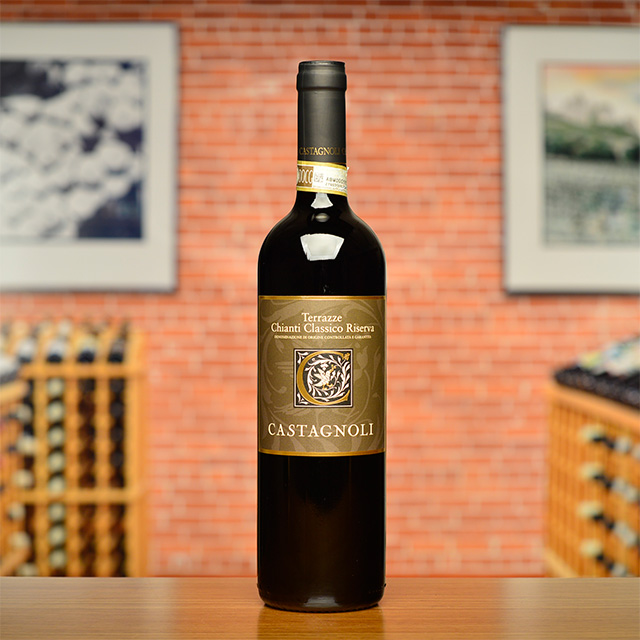Notify me
2014 Chianti Classico Riserva “Terrazze”
Castagnoli
It’s a treat to taste a sublime Chianti Classico with nearly a decade of age. Sangiovese that has been farmed with as much devotion as it receives at Castagnoli only gets more perfect over time. Some of the bright fruit has faded a little, but more nuanced, floral, and sanguine notes have emerged in the forefront, making this a dream bottling to open the next time you pan-sear a ribeye or roast a chicken.
—Tom Wolf
| Wine Type: | red |
| Vintage: | 2014 |
| Bottle Size: | 750mL |
| Blend: | Sangiovese |
| Appellation: | Chianti Classico Riserva |
| Country: | Italy |
| Region: | Tuscany |
| Producer: | Castagnoli |
| Winemaker: | Alfred Schefenacker |
| Vineyard: | 10 years average, 6.53 ha |
| Soil: | Galestro Schist |
| Aging: | Wine is raised in 500L barrels (none or very little new depending on vintage) |
| Farming: | Organic (certified) |
| Alcohol: | 14% |
More from this Producer or Region

2022 Chianti Classico
Italy | Tuscany
December Club Gourmand ~ A delicious Chianti Classico for now or later, with extraordinary potential at table.

Extra Virgin Olive Oil
Italy | Tuscany
Bright, intense green with hints of fennel and parsley, a Tuscan treasure.

2023 Rosso di Montalcino
Italy | Tuscany
Sesti‘s Rosso di Montalcino, with its seductive and mood-enhancing perfume, is like a delicious elixir of black cherry, bitter herbs, and fragrant violet.

2018 Brunello di Montalcino Riserva “Santa Maria”
Italy | Tuscany
This Santa Maria is coursing with raw beauty, exuding rose petals and turned earth and finishing with tannins fine as silk.

2019 Chianti Classico “Ai Lecci”
Italy | Tuscany
This new release highlights a parcel shielded from the hottest hours of afternoon sun by tall silver oaks (lecci), yielding a gentler Chianti characterized by dark, sultry fruit, luxurious spice, and velvety tannins.

2017 Brunello di Montalcino
Italy | Tuscany
This 2017 is compact and absolutely brimming with energy, culminating in a grippy, stony tannin.

2019 Chianti Classico Riserva “Terrazze”
Italy | Tuscany
A decidedly bright, aromatic, almost exotic Chianti, with aromas of black olive, violets, iron, and smoked meat.

2008 Brunello di Montalcino
Italy | Tuscany
**Extremely limited quantities, maximum two bottles per purchase.**

2022 Rosso di Montalcino
Italy | Tuscany
The perfume of rose petals and vivid red berry fruit, along with the delicate, fine-grained tannin, make this a truly special Rosso.
 /
/
About The Producer
Castagnoli
About The Region
Tuscany

Perhaps no region is tied to Italy’s reputation as a producer of fine wine as much as Tuscany. Since Etruscan times, viticulture has played a prominent role in this idyllic land of rolling hills, and the Tuscan winemaking tradition remains as strong as ever today. With a favorable Mediterranean climate, an undulating topography offering countless altitudes and expositions, and a wealth of poor, well-draining soils, conditions are ideal for crafting high-quality wines. Add to that the rich gastronomical tradition—Tuscany is home to some of the country’s finest game, pastas, salumi, and cheeses—and you have the blueprint for a world-class wine region.
This is Sangiovese territory; in fact, it is arguably the only place in the world where Sangiovese reaches a truly regal expression. In spite of a rocky history with fluctuations in quality, traditionally produced Chianti has reclaimed its status as one of the country’s most reliable, food-friendly reds, while the rapid rise of Brunello di Montalcino shows the grape’s potential for grandiose, opulent reds allying power and finesse. Traditionally-minded growers have stuck to using only indigenous grape varieties and employing techniques like aging in massive wooden casks known as botti, creating wines of terroir that shine at the Tuscan table.
Tuscan wines have had a place in our portfolio since Kermit’s first visit in 1977. While the names of the estates have changed, the spirit of those first unfiltered Chiantis he imported live on through our current selections.
More from Tuscany or Italy
2019 Chianti Classico “Ai Lecci”
Villa di Geggiano Italy | Tuscany
2022 Chianti Classico
Castagnoli Italy | Tuscany
2008 Brunello di Montalcino
Poggio di Sotto Italy | Tuscany
2021 Chianti Classico Riserva “Fondatore”
Podere Campriano Italy | Tuscany
2022 Rosso di Montalcino
J.G. Benda Italy | Tuscany
Extra Virgin Olive Oil
Sesti Italy | Tuscany
2020 Toscana Rosso “Brendino”
Cuna Italy | Tuscany
2019 Rosso di Montalcino
Ferretti Italy | Tuscany
2023 Rosso di Montalcino
Sesti Italy | Tuscany
2024 Toscana Rosato
Sesti Italy | Tuscany
2017 Brunello di Montalcino
Sesti Italy | Tuscany
2022 Toscana Rosso “Bandinello”
Villa di Geggiano Italy | Tuscany
2019 Chianti Classico “Ai Lecci”
Villa di Geggiano Italy | Tuscany
2022 Chianti Classico
Castagnoli Italy | Tuscany
2008 Brunello di Montalcino
Poggio di Sotto Italy | Tuscany
2021 Chianti Classico Riserva “Fondatore”
Podere Campriano Italy | Tuscany
2022 Rosso di Montalcino
J.G. Benda Italy | Tuscany
Extra Virgin Olive Oil
Sesti Italy | Tuscany
2020 Toscana Rosso “Brendino”
Cuna Italy | Tuscany
2019 Rosso di Montalcino
Ferretti Italy | Tuscany
2023 Rosso di Montalcino
Sesti Italy | Tuscany
2024 Toscana Rosato
Sesti Italy | Tuscany
2017 Brunello di Montalcino
Sesti Italy | Tuscany
2022 Toscana Rosso “Bandinello”
Villa di Geggiano Italy | Tuscany
Kermit once said...

Kermit once said...
You don’t have to be rich to cellar a great wine.















